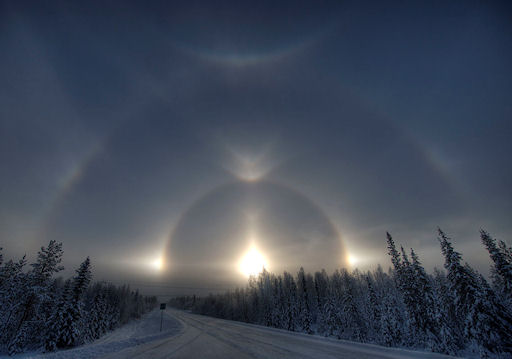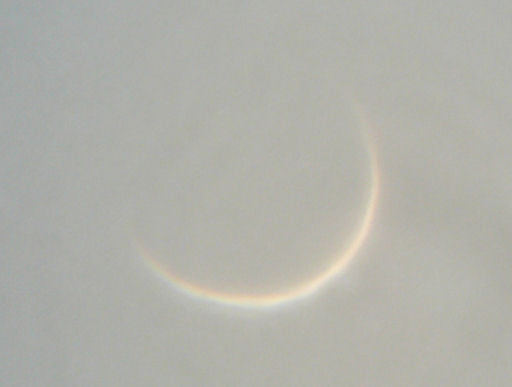RADAR IMAGES OF COMET HARTLEY 2: What is the shape of nearby Comet Hartley 2? On October 24th, astronomers used the giant Arecibo radar to image the comet's core. And the answer is ... "a cross between a bowling pin and a pickle," reports Tim Larson of NASA's Jet Propulsion Laboratory. According to the radar images, the "pickle" is 2.2 km long and spins around it's short axis once every 18 hours. The Deep Impact (EPOXI) probe will get a closer look on Nov. 4th when it flies by the comet at a distance of only 435 miles. Stay tuned.
COMET UPDATE: Amateur astronomers report that they can once again see Comet Hartley 2 through backyard telescopes as the morning moon fades in brightness. latest images: #1, #2, #3.
AMAZING HALOES: On Oct. 30th in Kittilä, Finland, photographer Sauli Koski witnessed a brief but unforgettable display when the rising sun shone through a morning cloud of wintery ice crystals. Fortunately he had his camera:

Full sized images: labeled or unlabeled
"These were the best ice haloes I have ever seen," says Koski. "They were there for only about 10 minutes and then gone. What a delight!"
"It was a gem of a halo display," agrees atmospheric optics expert Les Cowley. "Koski saw at least 13 different arcs. Some, including two types of Parry arc, are rare. Three more arcs, the helic, Parry supralateral, and Moilanen are exceedingly rare. See the key for the arc identities. With winter fast approaching, now is the time for outstanding halos."
more images: from Oleg Toumilovitch of Johannesburg, South Africa; from Inge Malan of Woodmead, Johannesburg, South Africa; from Dawn Wyngaard of Johannesburg, South Africa; from Tinyiko Chauke of Pretoria, Gauteng ,South Africa
DANGEROUS BEAUTY: As November begins, Venus is passing almost directly between Earth and the sun, an event astronomers call "inferior conjunction." The view through a telescope is both beautiful and dangerous. Henry Mendt of Maracaibo, Venezuela, took this daylight picture of Venus only 7o from the blinding sun on Oct. 31st:

Venus is such a slender crescent because the planet's night side is almost-squarely facing Earth. "Only 0.7% of the disk was illuminated," says Mendt, "but the crescent was bright and wide, a full arcminute in diameter. This made Venus easy to find even in the midday sky." Here he describes how he safely targeted Venus using an 8-inch telescope and photographed the planet from inside the shadows of a parking garage.
Venus will become even easier to find in the weeks ahead as it emerges from the glare of the sun into the pre-dawn sky. The crescent will be a little fatter, but much less dangerous and no less beautiful. Stay tuned for the Morning Star.
more images: from Somsawat Rattanasoon of Chiang Mai, Thailand; from Jim Werle of Henderson, Nevada
October 2010 Aurora Gallery
[previous Octobers: 2009, 2008, 2007, 2006, 2004, 2003, 2002, 2001]
Potentially Hazardous Asteroids (
PHAs) are space rocks larger than approximately 100m that can come closer to Earth than 0.05 AU. None of the known PHAs is on a collision course with our planet, although astronomers are finding
new ones all the time.
On November 1, 2010 there were 1157 potentially hazardous asteroids.
Notes: LD means "Lunar Distance." 1 LD = 384,401 km, the distance between Earth and the Moon. 1 LD also equals 0.00256 AU. MAG is the visual magnitude of the asteroid on the date of closest approach. | | The official U.S. government space weather bureau |
| | The first place to look for information about sundogs, pillars, rainbows and related phenomena. |
| | Researchers call it a "Hubble for the sun." SDO is the most advanced solar observatory ever. |
| | 3D views of the sun from NASA's Solar and Terrestrial Relations Observatory |
| | Realtime and archival images of the Sun from SOHO. |
| | from the NOAA Space Environment Center |
| | the underlying science of space weather |

